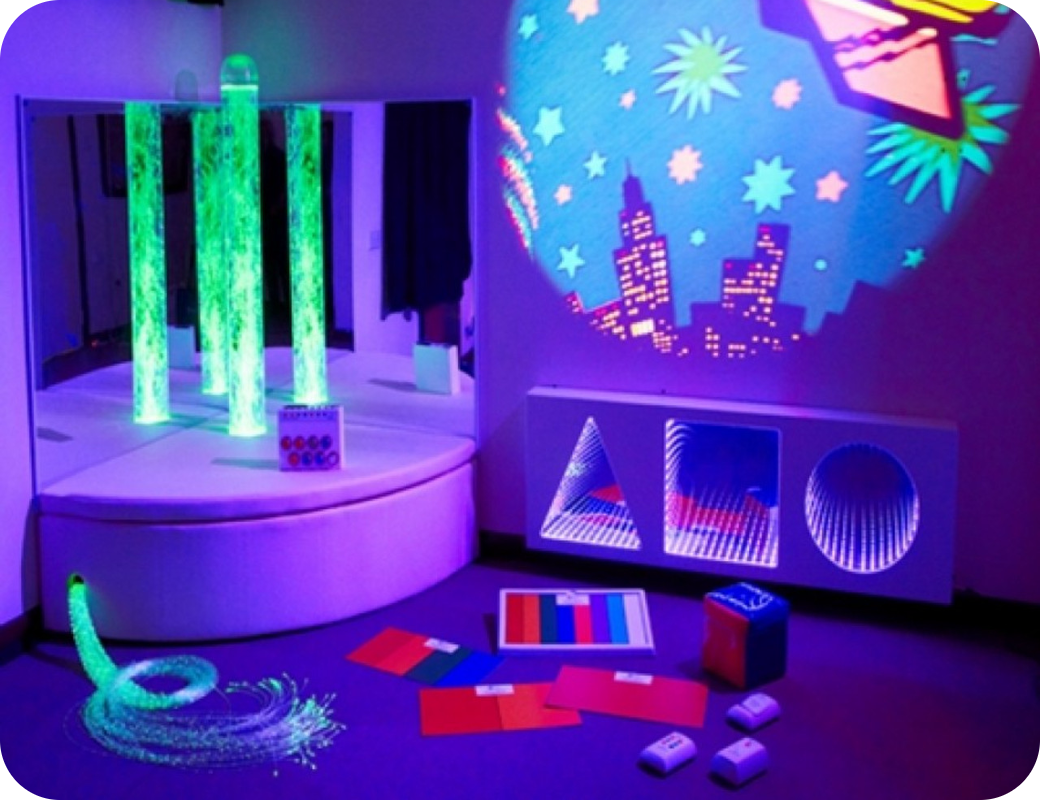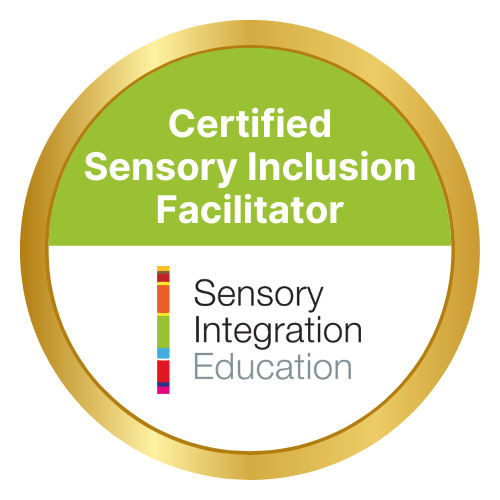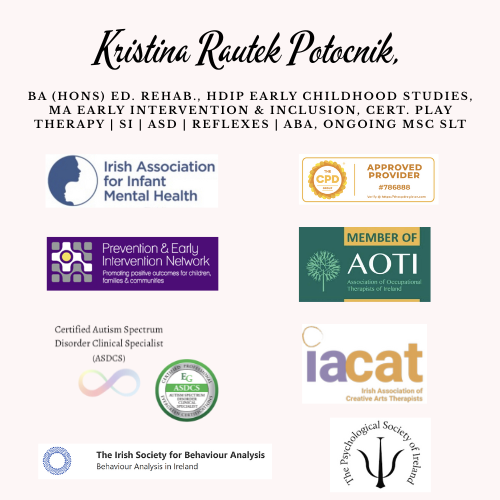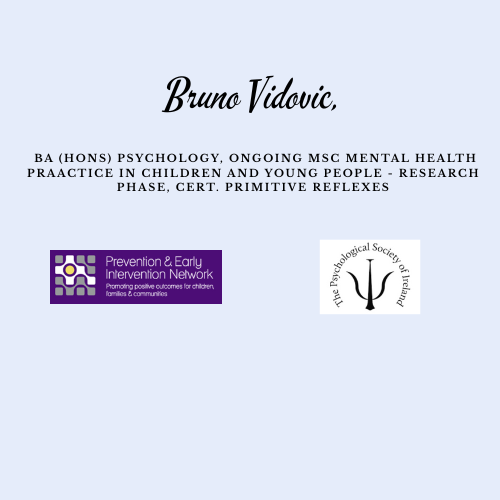Why Sensory Rooms in Preschools Might Be Doing More Harm Than Good

Author: Kristina Rautek Potocnik, BA (Hons) Ed. Rehab., HDip Early Childhood Studies, MA Early Intervention & Inclusion, Cert. Play Therapy | SI | ASD | Reflexes | ABA, ongoing MSc SLT
Over the last few years, sensory rooms have become increasingly popular in preschools and primary schools. Across social media, we often see posts showcasing beautifully equipped spaces filled with glowing lights, soft cushions, fibre optic strands, textured panels and swings. These rooms are frequently funded through community grants or fundraising efforts, and there’s no doubt that the motivation behind them is rooted in care and inclusion.
Still, one uncomfortable truth remains: a sensory room without a trained sensory integration specialist can unintentionally cause more problems than it solves. In fact, for children who are already overstimulated—as many in early years settings are—these spaces can quickly become overwhelming.
The root of the issue lies in a misunderstanding of how sensory systems actually work. Sensory integration is not about offering children as many sensations as possible. It’s about carefully matching the type, intensity and timing of sensory input to the specific needs of the individual child. Each item in a sensory room has a defined purpose. A weighted blanket, a vibrating cushion, or a wobble board can all be powerful tools—but only when used appropriately, and only when there is a clear reason to choose that input for a particular child. Without this understanding, sensory rooms risk becoming chaotic environments that overexcite, confuse, or even distress the children who use them.
One example from practice makes this point clear. In a preschool I supported, educators were concerned about a two-year-old boy who showed several difficulties. He struggled to maintain balance while climbing stairs or stepping onto elevated surfaces, and often played in an unusually rough way, both with toys and with other children. The staff assumed he had sensory processing difficulties and began exposing him daily to tactile activities—such as sand play and textured materials—as well as spending time with him on the swing.
Weeks passed, and nothing changed. The child remained unsteady, frustrated, and unpredictable in his social interactions. This is not surprising. The behaviours described by the educators had little to do with the tactile system. Instead, they indicated challenges with balance and visual-motor coordination. In this case, swinging might have actually worsened the problem, as vestibular input can be disorganising for children whose balance systems are not yet well developed.
This kind of mismatch happens more often than we like to admit. A well-equipped room without professional guidance can easily become a source of overstimulation, confusion, or even sensory shutdown. That’s why the most powerful thing any early years setting can do is not to buy more equipment—but to build knowledge.
Understanding the basic functions of sensory systems allows educators to observe behaviour differently. A child who constantly seeks movement might not be “hyperactive”—they might be trying to regulate their vestibular system. A child who avoids messy play might not be “fussy”—they may be hypersensitive to tactile input. Recognising these patterns helps educators respond with purpose, choosing activities and strategies that actually support the child’s regulation and development.
In many preschools, this shift in perspective has brought significant results. Instead of relying on designated sensory rooms, educators are creating calm corners and quiet zones within their classrooms—small spaces where children can retreat, regulate, and rejoin the group when ready. These are not fancy or expensive. A soft mat, a few well-chosen textures, a simple tent or beanbag, and a consistent approach to emotional safety can be more effective than a fully equipped sensory room.
Another practice that has proven particularly useful is the use of sensory-motor stories. These are structured, engaging narratives designed to combine movement, rhythm, and sensory input in a playful and meaningful way. Children are invited to move through a story—crawling through imaginary tunnels, jumping over rivers, tiptoeing past sleeping animals, or squeezing through narrow spaces. Each movement is selected for its sensory impact, whether it activates the proprioceptive system, stimulates balance, or calms the nervous system. What makes these stories special is that they do not require any special equipment. They can be done in a circle time space, in a hallway, or even outdoors. And yet, they offer rich opportunities for sensory regulation, body awareness, and group participation.
These stories are not a replacement for professional therapy, but they are a powerful everyday tool for educators and parents who want to support sensory development in a structured, accessible way. When used regularly, they help children develop better coordination, attention, and emotional balance—all within the rhythm and flow of play.
In conclusion, while sensory rooms may look impressive and offer some benefits when used with expertise, they are not the only—or the best—way to support children’s sensory needs. What matters most is not the room itself, but the knowledge and intention behind every interaction. Sensory development happens every day, in every part of the classroom, and in every relationship a child experiences. When we understand that, we can move from overstimulation toward true regulation, from equipment toward connection, and from confusion toward clarity.
Latest Posts
- How children make sense of the world through their senses
- How your baby learns about the world through their senses
- Helping your child grow stronger through movement and play
- Understanding How Early Intervention Helps Children Learn, Move, and Connect
- How to Recognise Tactile Defensiveness and Help Your Child Feel Safe
- Understanding Feeding Challenges and How to Support Your Child at Home
- Let’s Talk Sitting: Exploring Floor Seating Options
- Retained Primitive Reflexes: The Hidden Cause Behind Developmental Struggles
- Where Curiosity Blossoms: How Children's Play Nurtures Growth for All
- Helping Your Child Through Stress: A Gentle Guide for Parents
- Sweet Little Lies – How to Recognise and Respond with Care
- Chores Are More Than Just Tasks – They’re a Tool for Growing Independence, Focus, and Confidence
- How to Help Children Develop Emotional Intelligence
- Blending Technology and Care: How VR Meta Quest Supports Children at NeuroNest
- A simple guide for parents who want to raise confident, happy children
- Setting Boundaries with Love: A Simple 3-Step Guide for Parents
- Understanding Behavior Through the Nervous System
- A Compassionate Lens on Dysregulation in Non-Speaking Autistic Individuals
- Supporting Development Through Movement: The Role of the Swing in Early Intervention
- Blending Tradition and Innovation: How NeuroNest Supports Your Child’s Unique Journey
- When Movement Meets Innovation: Supporting Child Development with GoBalance
- Why Visual Perception Matters for Everyday Life and Development
- Benefits of Chess in Early Intervention
- Building Healthy Nutrition from the Start
- A Journey Back to Your True Self
- Supporting Your Child’s Hand Skills for Confident Writing
- Blending the Best of Both Worlds
- Helping Toddlers Eat Well: A Parent’s Guide
- Why Tummy Time Matters for Your Baby's Development
- Helping Your Child Build Everyday Independence
- Who Are the Disconnected Kids?
- From First Tries to Automatic Habits: Understanding the Stages of Skill Learning
- Why a Child’s Level of Alertness Matters for Memory and Learning
- Early brain development starts before birth
- Why Slowing Down, Adapting Tasks, and Adding Breaks Helps Children Learn Better
- Why ADHD, Autism, Dyslexia and Other Challenges Need a New Approach
- The surprising power of copying in child development
- Books are more than just language tools—they’re powerful allies in sensory and motor development.
- Rethinking sensory support: moving beyond expensive rooms toward everyday understanding.
- Understanding how fear develops in a child’s brain
- Understanding how an early baby reflex can affect your child’s daily life
- A gentle start into baby development through movement and bonding
- A child-centred, research-informed approach that uses the power of play to support communication, emotional regulation, motor development, and meaningful growth from infancy to twelve years.
Our Partners




Our Memberships


